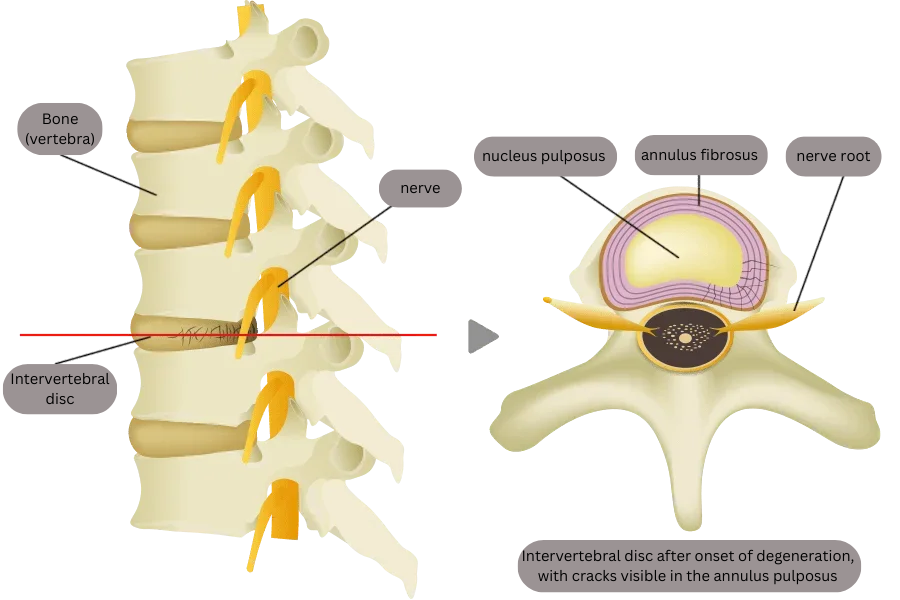Column Understanding Disc Herniation and Receiving the Most Appropriate Treatment For It
2023.06.15
When asked what the most common back condition is, most people usually say disc herniation.
Today in this column, we will explain what disc herniation is.
What is disc herniation?
Intervertebral discs are located between each vertebra. Each disc has a gelatinous nucleus pulposus in the center and a collagen-rich annulus fibrosus encapsulating the nucleus pulposus.
Disc herniation occurs when the annulus fibrosus cracks and the nucleus pulposus protrudes outward.

How does a herniated disc occur?
Without the occurrence of disc issues, strenuous exercise causes little or no effect on the surrounding bones and ligaments because the energy is absorbed by the disc, which acts as a protective cushion.
Chronic back pain and neuropathy do not appear in children because their discs have a healthy cushioning function.

However, as early as around age 16, the intervertebral discs begin to sustain damage.

When cracks occur in the annulus fibrosus, the nucleus pulposus inside rapidly protrudes, resulting in herniation. When the nucleus pulposus protrudes slowly, the herniation is less noticeable, but the nucleus pulposus gradually loses its volume, causing a loss of disc function.

Eventually, the loss of cushioning function increases the strain on the spine and begins to deform the spine and ligaments, causing intervertebral arthritis and ligament ossification, which can lead to spinal canal stenosis and intervertebral foraminal stenosis.

This in turn leads to damage of the intervertebral discs, and to the development of various spinal conditions.

For this reason, it is important to repair the disc to be able to treat the underlying cause.
Pain caused by disc herniation
A herniated disc is known to cause pain in the lower back and buttocks, as well as pain and numbness in the legs.
However, even if an MRI scan diagnoses severe herniation, there may be no pain, and conversely, a mild herniation can result in severe pain.
Recent studies have shown that the pain resulting from a herniated disc is not caused by physical nerve compression from the protruding nucleus pulposus, but rather by inflammation from the freshly protruded nucleus pulposus.
The inflammation has also been found to dissipate spontaneously over a fixed period of time (usually a few months).
Hernias may spontaneously resorb after inflammation, or they may remain in residual form. Residual hernias may appear as severe hernias on imaging studies, but because they are post-inflammatory, they are asymptomatic.
If the pain persists for more than a few months, it means that a new nucleus pulposus has been leaking continuously. If the pain improves, it means that the nucleus pulposus has stopped leaking.
This is very important to understand the condition of a herniated disc.
Treatment of disc herniation
Conservative Therapy
Conservative therapy also includes medication and exercises.
Drug therapy
Once a herniated disc has been diagnosed, non-steroidal anti-inflammatory analgesics such as Loxonin and Voltaren, muscle relaxants, opioid analgesics, and neuroleptics are used to reduce the inflammation and pain. Medications must be taken for a long period of time until the hernia is gone, and symptoms disappear.
Exercise Therapy
Prolonged periods of rest after low back pain may lead to prolonged low back pain. Therefore, instead of resting, stretching and other rehabilitative exercises may be used to improve back pain.
Surgery
After the onset of pain, surgery is considered to be indicated when the symptoms do not subside following conservative treatment.
In surgery, the leaking nucleus pulposus (the herniated part) is removed to relieve pain and inflammation. Hernia removal by laser may be recommended for mild hernias. If the hernia is severe and there are severe symptoms such as movement disorders, early surgery such as endoscopic surgery is recommended.
However, surgical procedures cannot close the cracks in the annulus fibrosus. Therefore, the nucleus pulposus continues to leak even after surgery, leading to a high probability of the recurrence of the hernia in the future.
Treatment at our clinic
Our clinic offers the Cellgel method, a treatment to repair the damaged disc.
In our Cellgel procedure, we inject a drug that fills in the cracks in the disc, which then becomes a gel that repairs the cracks, thus providing a cure at root level. It is characterized by the fact that the volume of the disc is not reduced, and the drug remains in the disc as a gel-like implant after treatment, thus preserving the disc.
If you have been diagnosed with a herniated disc in the past or currently suffer from back pain, please consider reserving for a consultation.
Related Articles
Recurrence and Reoperation of Lumbar Disc Herniation: Proper Understanding For Appropriate Treatment
Recurrence of Herniated Discs: on the Necessity of Revision Surgery and the Criteria for it.



